Today, Leica has announced the SL2, its next-generation professional mirrorless camera. The original Leica SL (Typ 601), introduced in late 2015, set the standard for mirrorless cameras. From its cutting-edge 4.4MP EVF, touchscreen interface, rapid shooting rate, quick autofocus, 4K capabilities, and more, the SL still keeps pace today. But with the launch of the SL2, Leica has improved upon the SL in every way that matters and brought to bear a worthy successor.
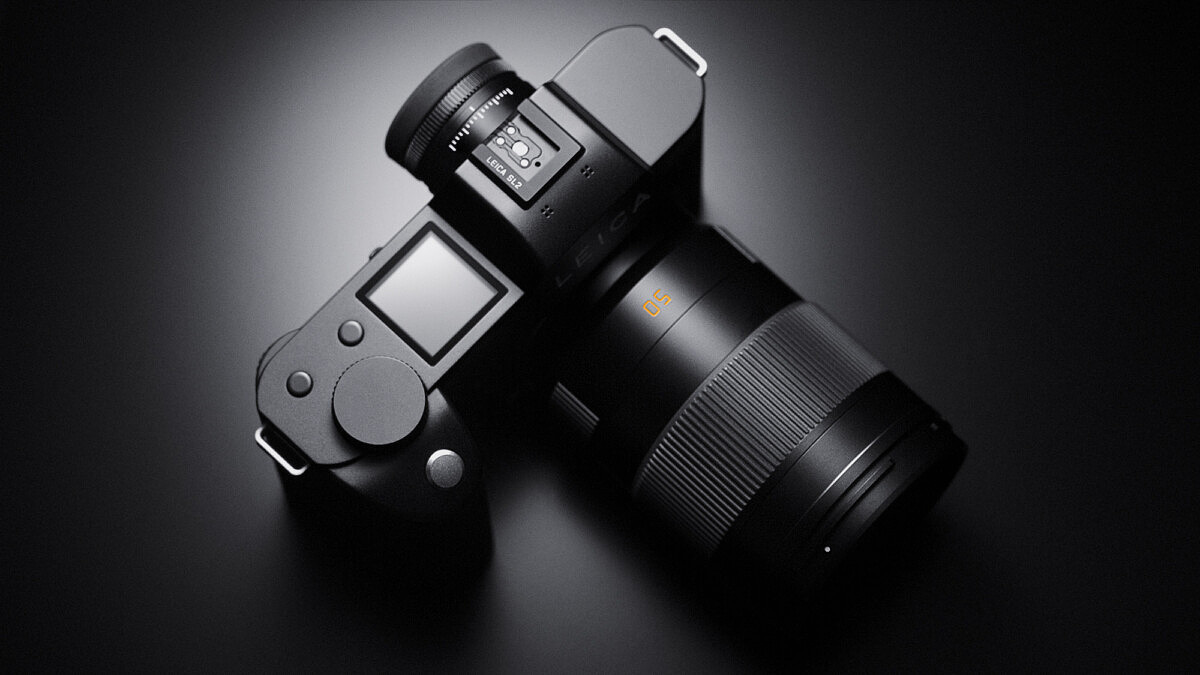
Built around a 47MP CMOS sensor offering double the resolution of the SL, the SL2 features a speedy Maestro III processor, 5-axis in-body image stabilization, a top-of-the-line 5.76MP OLED EVF, larger and more detailed 3.2” touchscreen, updated Wi-Fi, dual UHS-II SD card slots, mutishot capability for enormous 187MP files, a USB 3.1 Type-C port for tethering and power, and some of the most impressive video specs yet from a hybrid mirrorless system. To name just a few. Let’s take a look at these in a bit more detail and see how the SL2 improves upon its predecessor.
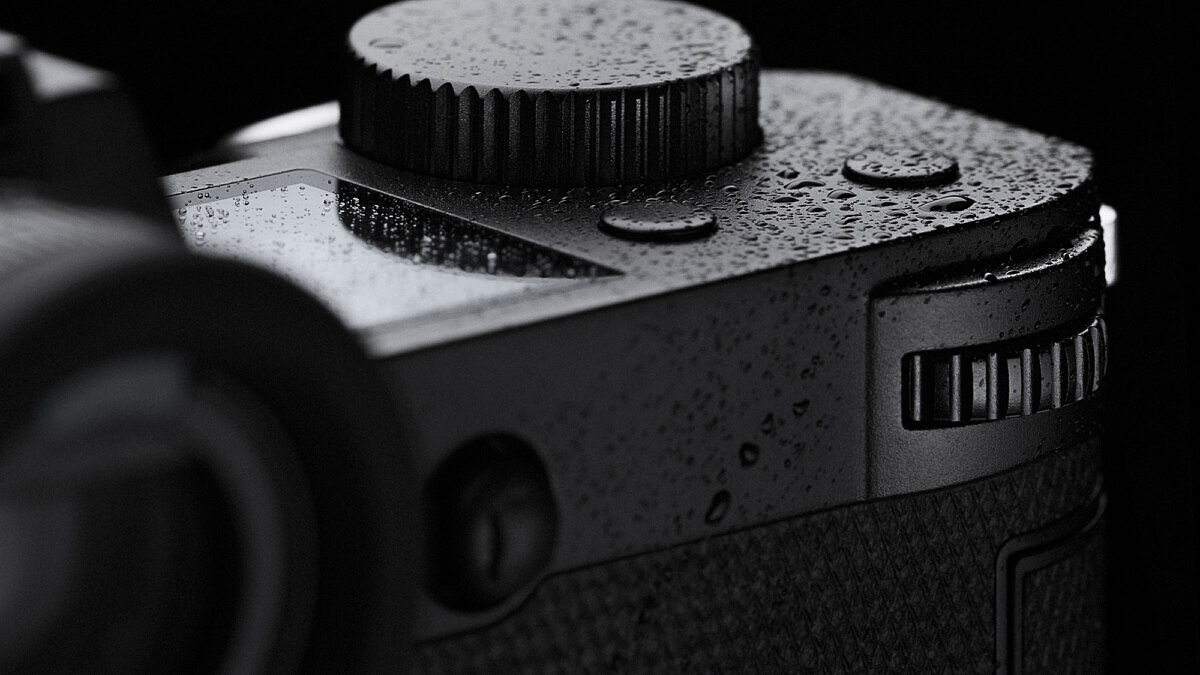
New Sensor
The full frame 47MP CMOS sensor in the SL2 yields roughly twice the resolution of the original SL. Delivering up to 14 stops of dynamic range with an ISO range of 50 – 50,000, the sensor can handle just about anything you throw at it. From landscape to night photography, you’ll be greeted with incredible details paired with gorgeous colors and tonality. The sensor also features proprietary microlenses which maximize performance when used with Leica M lenses. As, usual, there’s no anti-alias filter to interfere with capturing the finest details.
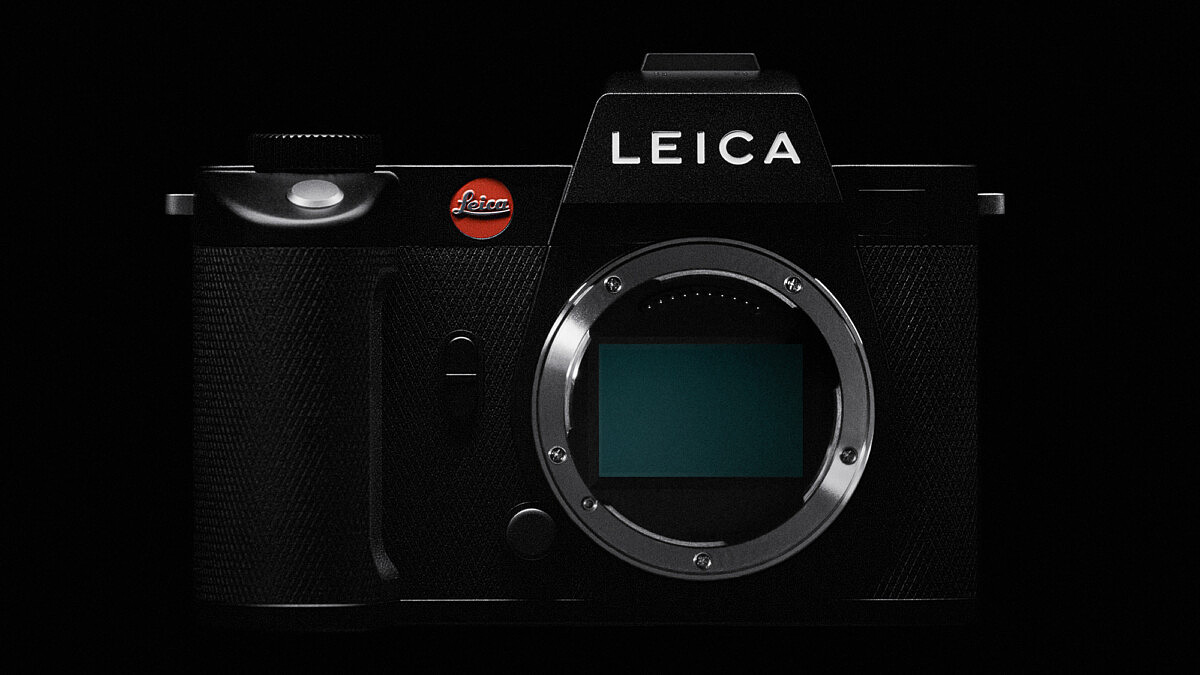
More Processing Power
The camera can shoot up to a staggering 20 frames per second in maximum drive mode at full resolution. So, to churn through all those pixels the SL2 sports a custom Maestro III processor. This next-generation chip enables responsive operation under all circumstances from capture to playback and enables some impressive video specs as well.
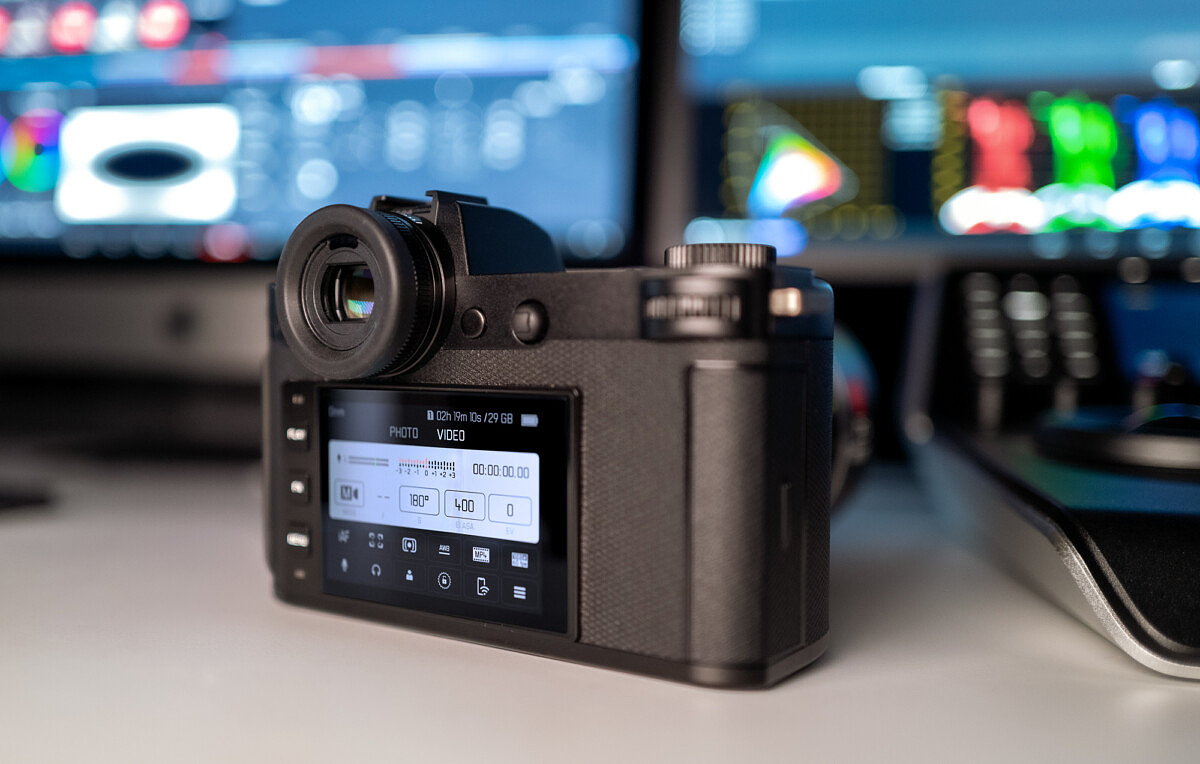
4GB Buffer
To support the upgraded sensor and processor, the SL2 packs twice the buffer memory of the SL. With its generously-sized 4GB buffer, expect to shoot around 70 shots in burst before the camera slows down when recording 14-bit DNG files, or well over 100 frames in JPG if that's your thing.
Dual UHS-II SDXC card slots
You’ll need a fast card to record all that information. The SL already features a single UHS-II slot and a secondary UHS-I for backup. On the SL2, both slots are full UHS-II speed, enabling the additional capacity of two cards with rollover or real-time redundant backup with speeds up to 300MB/s on both slots.
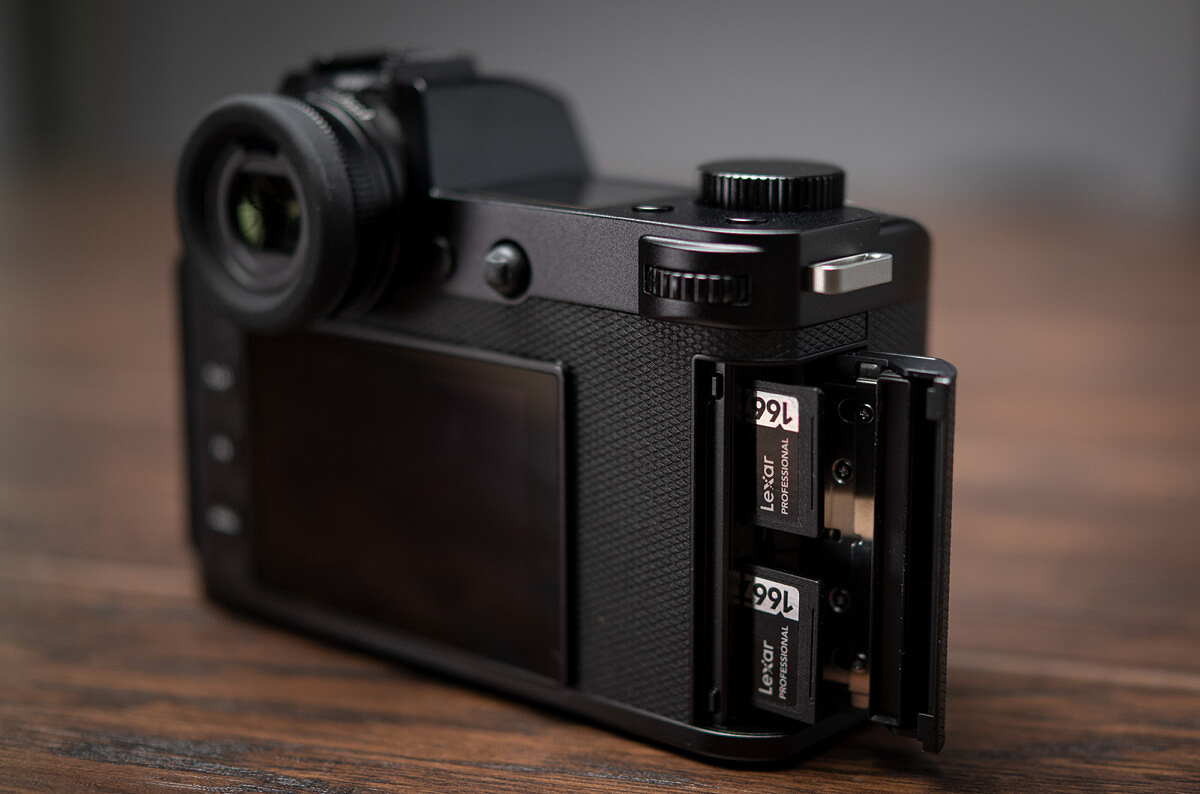
IBIS
Just as significant as the jump in resolution is the addition of in-body image stabilization, or IBIS for short. The 5-axis mechanical stabilization physically moves the sensor to correct for pan, tilt and rotation. With just the in-body stabilization, expect around five and half stops of effective shake reduction. Add on one of Leica’s SL zooms with OIS (optical stabilization) and the combined correction can be more than six stops. This feature should prove to be an absolute game changer for users of M lenses, when employed with the latest APO-Summicron-SL primes, or when shooting run-and-gun handheld video.
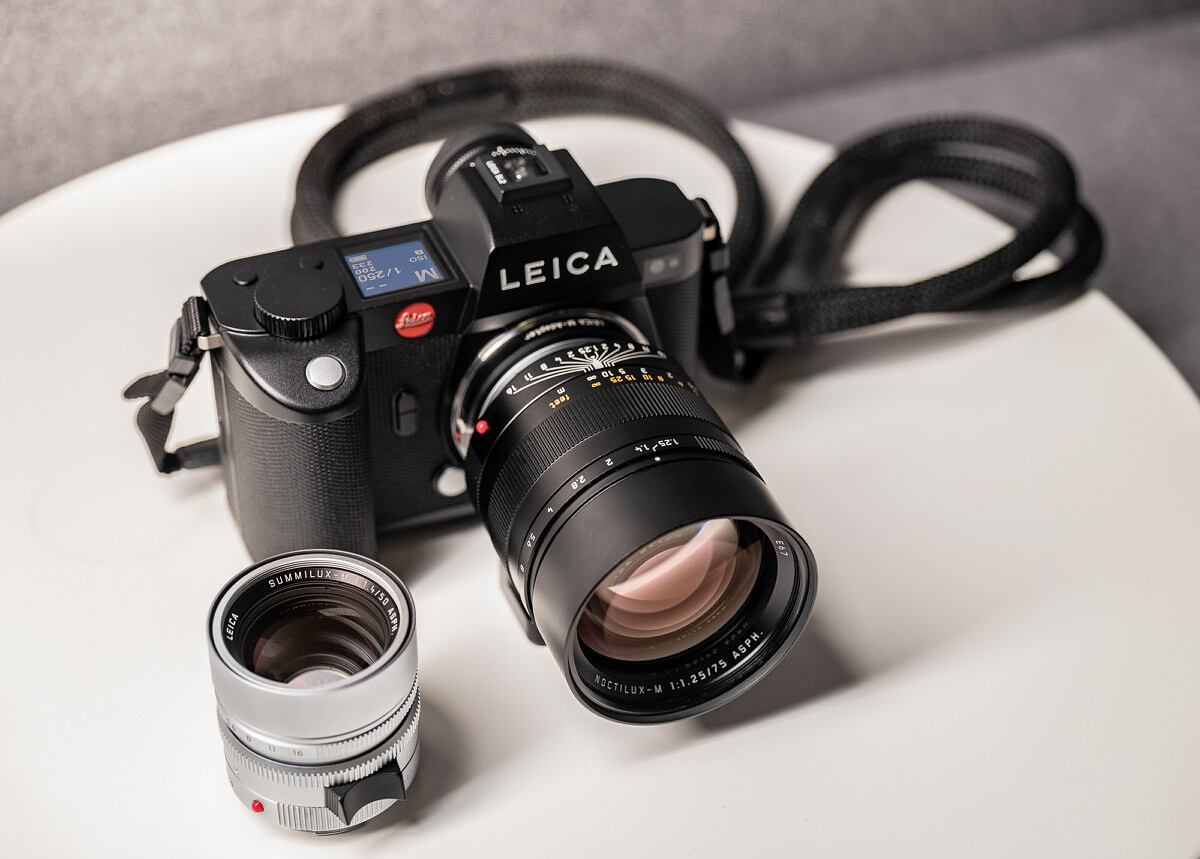
5.76 MP OLED EVF
The 4.4 MP EVF on the first SL was unmatched for years, but this new higher resolution Eye-Res EVF just puts it to shame. The switch to OLED from LCD is noticeable. Color gamut and accuracy are vastly improved, as is sharpness. A 120fps refresh rate ensures a silky-smooth and responsive viewing experience with no image tearing or detail smearing. Generous eye relief, plentiful magnification and an all-glass optical path treat even eye glass wearers to a large, crystal-clear view. Once you experience the EVF, it will spoil you for anything else.
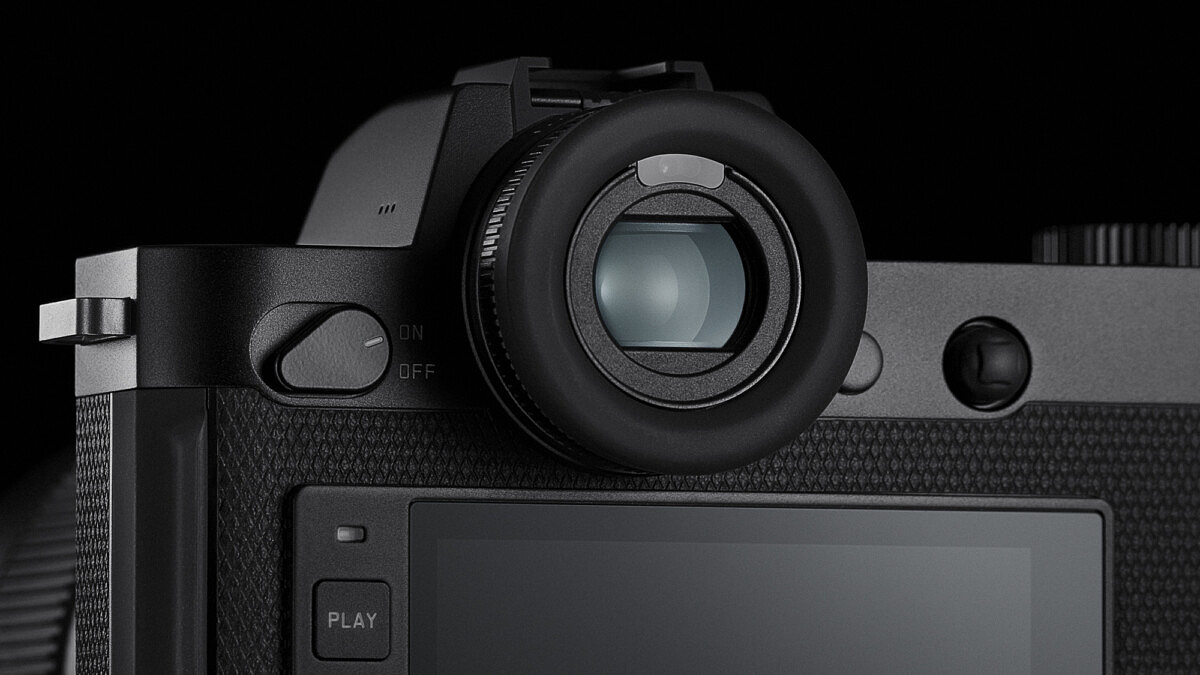
3.2” Touchscreen
A larger and higher resolution touchscreen graces the rear of the camera, featuring a redesigned menu interface. With 2.1 MP images and icons are crisp and easy to see. The Gorilla Glass surface resists fingerprint and scratches while cutting down on reflections.
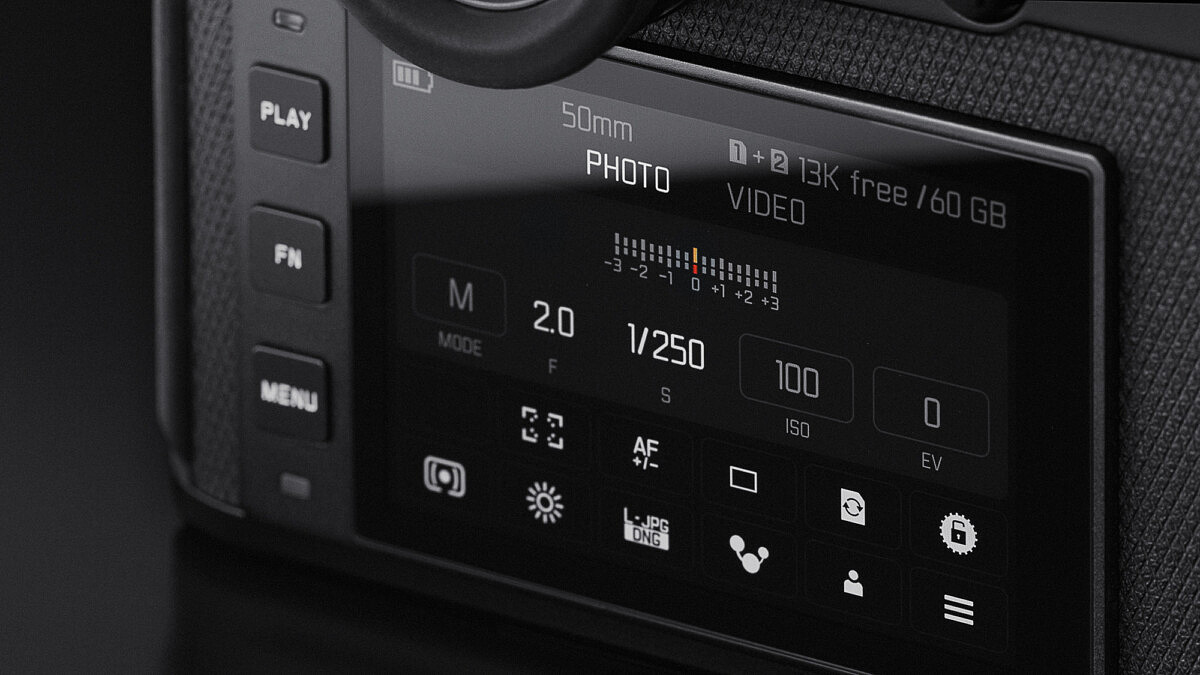
Multishot Function
Not available at launch, the mulitshot function will be coming via firmware update in early 2020. Capturing and combining eight images while shifting the sensor, the SL2 will assemble the results in-camera into a staggering 187MP single DNG file. As added insurance, a standard 47MP DNG is also included. With this high resolution multishot capture capability, the SL2 should exceed even 100MP medium format cameras in total detail, especially given the extreme resolving power of native SL optics.
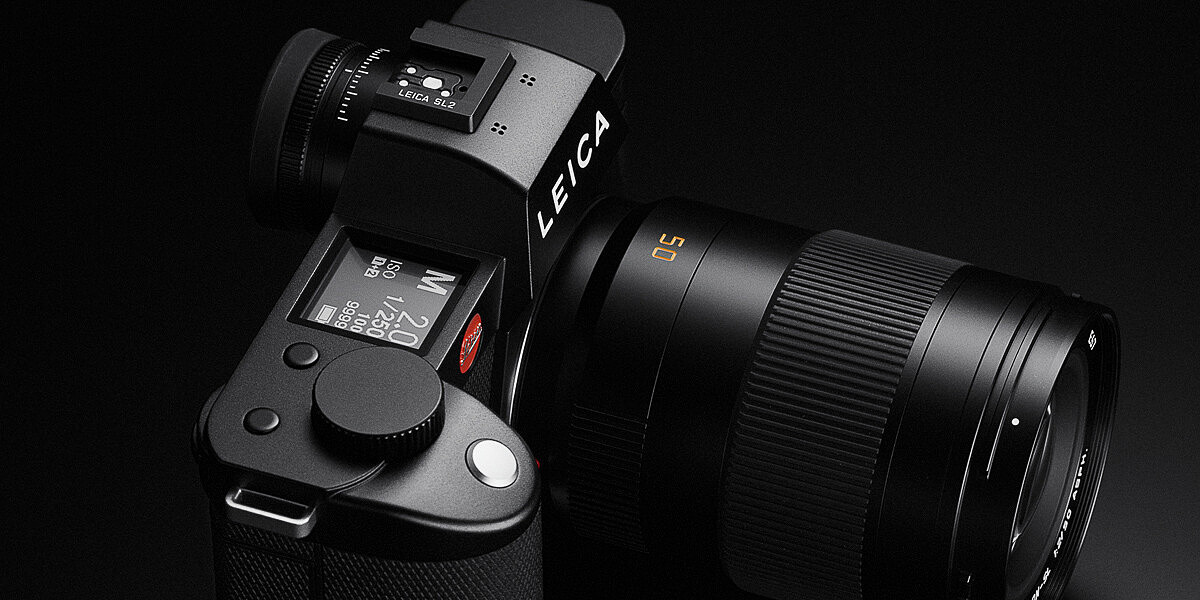
Updated Ergonomics
At first glance, the SL2 bears a strikingly similar resemblance to its forebearer the SL. Yet, upon closer inspection, you can definitely see some subtle but significant changes. Instead of a bare metal front and chunky rounded grip, the SL2 has a textured leatherette wrap around the entire body, with an undercut rubberized grip offering much greater comfort and added stability when shooting.
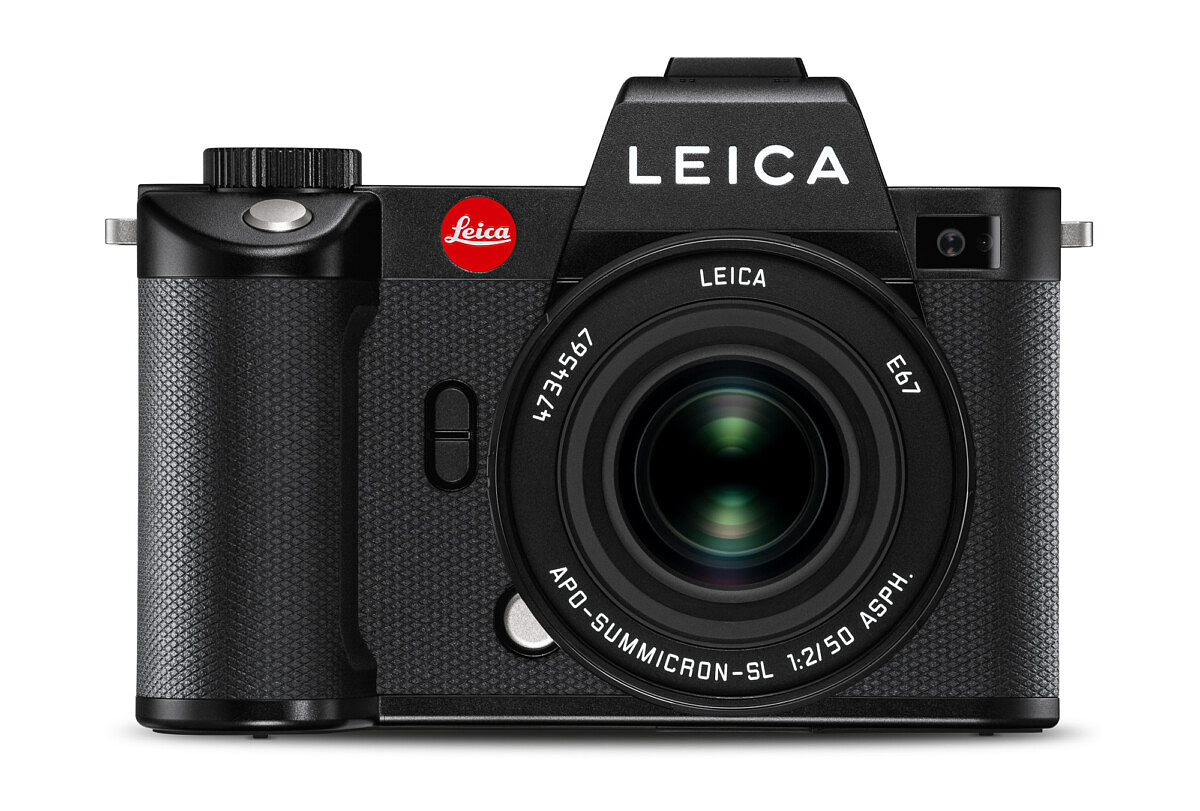
The front function button has been split into two, doubling up on the customization without cluttering the design. Flanking the rear LCD are the same three buttons that are now found on the M10, CL and Q2. This unified control design makes switching between different Leica cameras much simpler. The thumb joystick and rear dial remain, as well as the two programmable top buttons and button to the right of the EVF. All in all, you’ll be able to quickly set six customizable function buttons without having to dig through menus. Just like the CL and Q2, only a long press is required to assign a function with a short press to activate.
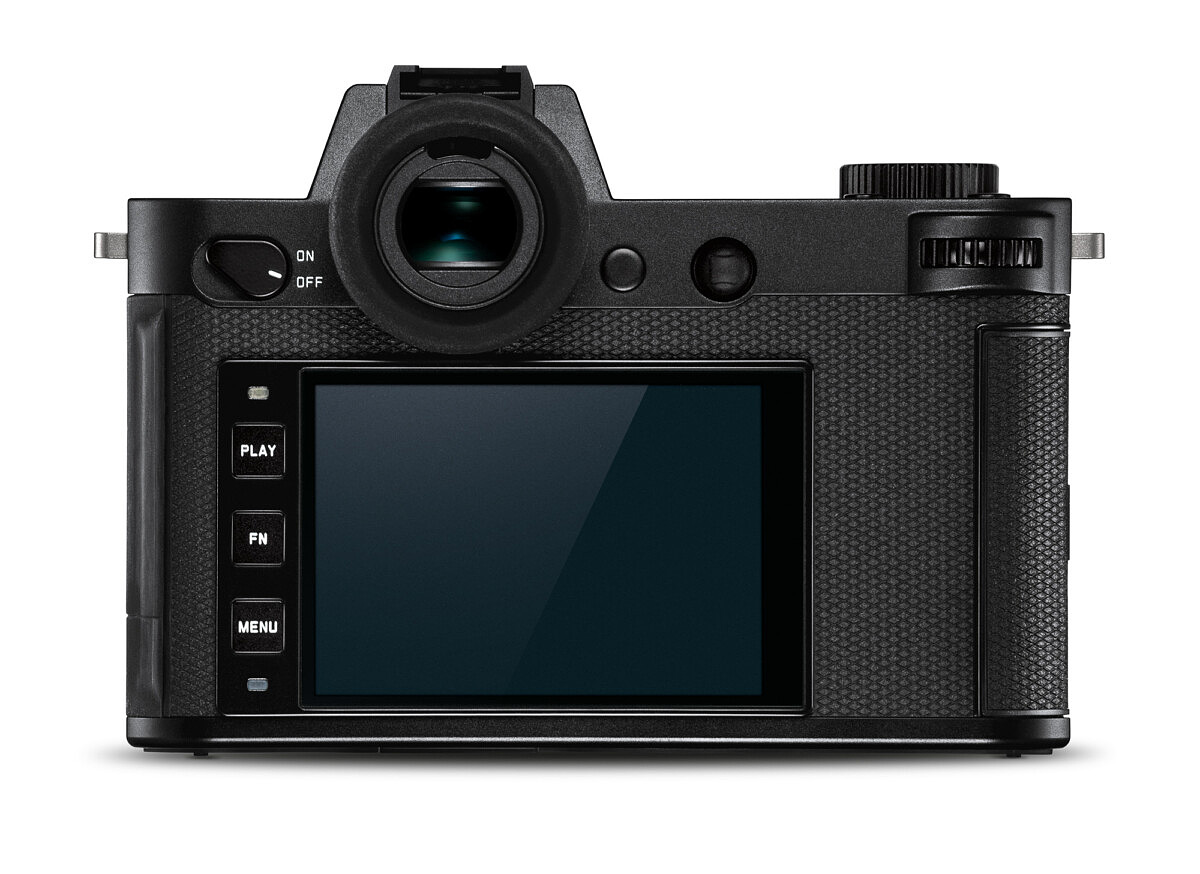
And to make things ever more intuitive, the status screen shows all critical camera settings at a glance, with different themes for photo and video. To change a setting, you can now simply tap on its icon and adjust with touch sliders, the joystick or rear thumbwheel. Straightforward and elegant.
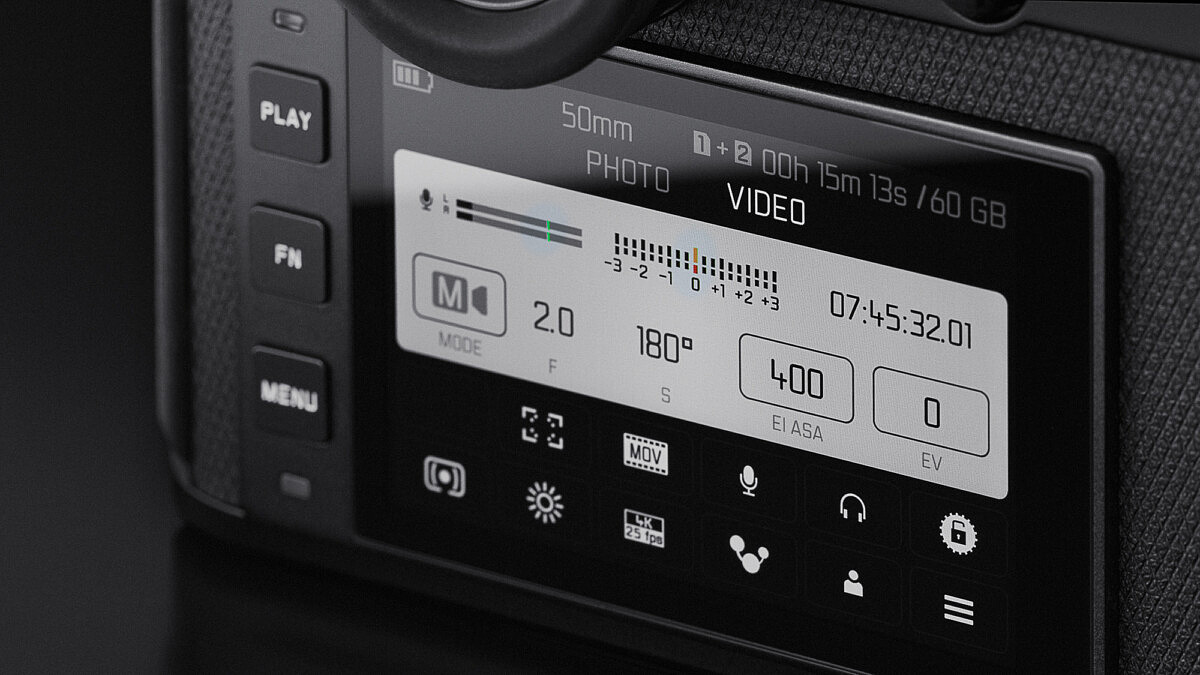
New Autofocus
The SL2 adds Intelligent AF with Leica Object Detection Autofocus. Now, the SL2 can detect faces and bodies, intelligently activating tracking when a subject moves in frame. Different AF profiles are available such as kids/pets, sports and wildlife to maximize performance in different shooting scenarios. AF points have been upped from 49 on the SL to 225 on the SL2 and now cover 100% of the frame.
Video including 5K and Cine4K 60 fps
The original SL features incredible 4K capture capability. Building on and expanding this expertise, the SL2 is now one of the most capable hybrid mirrorless video cameras on the market. We’ve got a Super35 cropped 5K mode, perfect for anamorphic capture, high speed FullHD capture up to 180 fps, and Cine4K up to 60 fps using the full width of the sensor. To my knowledge, the SL2 is actually the first mirrorless hybrid camera on the market with full frame Cine4K capture at 60 fps. Almost all video modes can be recorded using either the full sensor or a Super35 crop, useful if using PL-mount cine glass or smaller TL lenses.
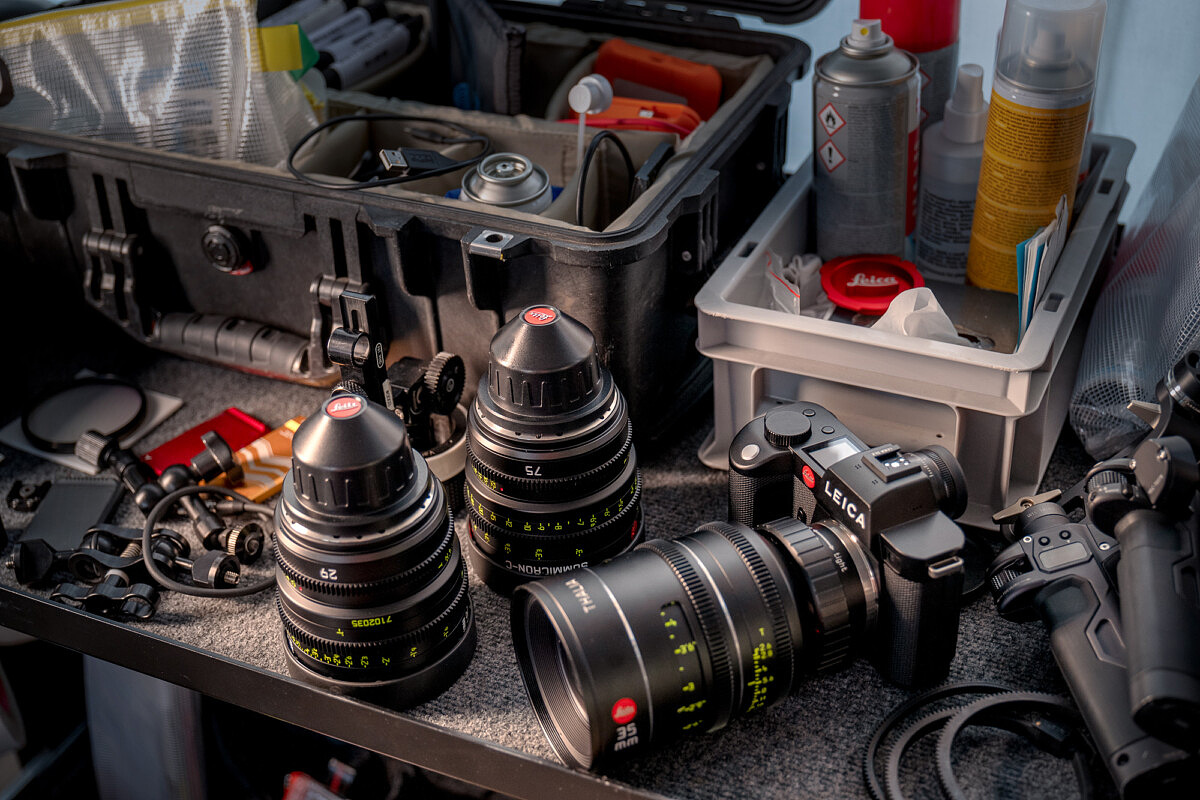
Up to Cine4K30 can be recorded straight to SD card in-camera with 10-bit 4:2:2 quality. Connect an Atomos Ninja V or Shogun 7 via the full size HDMI 2.0b port and you can record all the way up to Cine4K60 in 10-bit 4:2:2. Bit rate options abound with choices for MOV, MP4, All-I and Long GOP ranging from 20Mbps up to 400Mbps depending on your needs. For HDR shooting, HLG (Rec 2020) and L-Log options are on tap for all recording modes.
There’s also a new Cine Mode, which swaps in ASA for ISO and shutter angle for shutter speed, perfect for fitting in on a professional cine set.
Mic and Headphone Jacks
No more audio adapter required. The SL2 now has two standard 3.5mm audio jacks, one for microphone input and one for headphone output. Gain settings are available for each in the menu system.
USB 3.1 Type C
An upgrade from the SL’s USB 3.0 port, the new standard reversible connector supports charging, power, data transfer and stable tethering to a Mac or Windows PC. You can even power the camera in the field using a small powerbank or even from a V-Mount battery using a USB tap.
Upgraded Networking
In addition to the improved wired connections, the SL2 comes equipped with high-speed IEEE802.11ac Wi-Fi and Bluetooth LE 4.2. Still fully backwards compatible with IEEE802.11a/b/g/n, the newer radios offer far easier and quicker connection to the Leica FOTOS app, with BLE allowing for an always-on low-power connection.
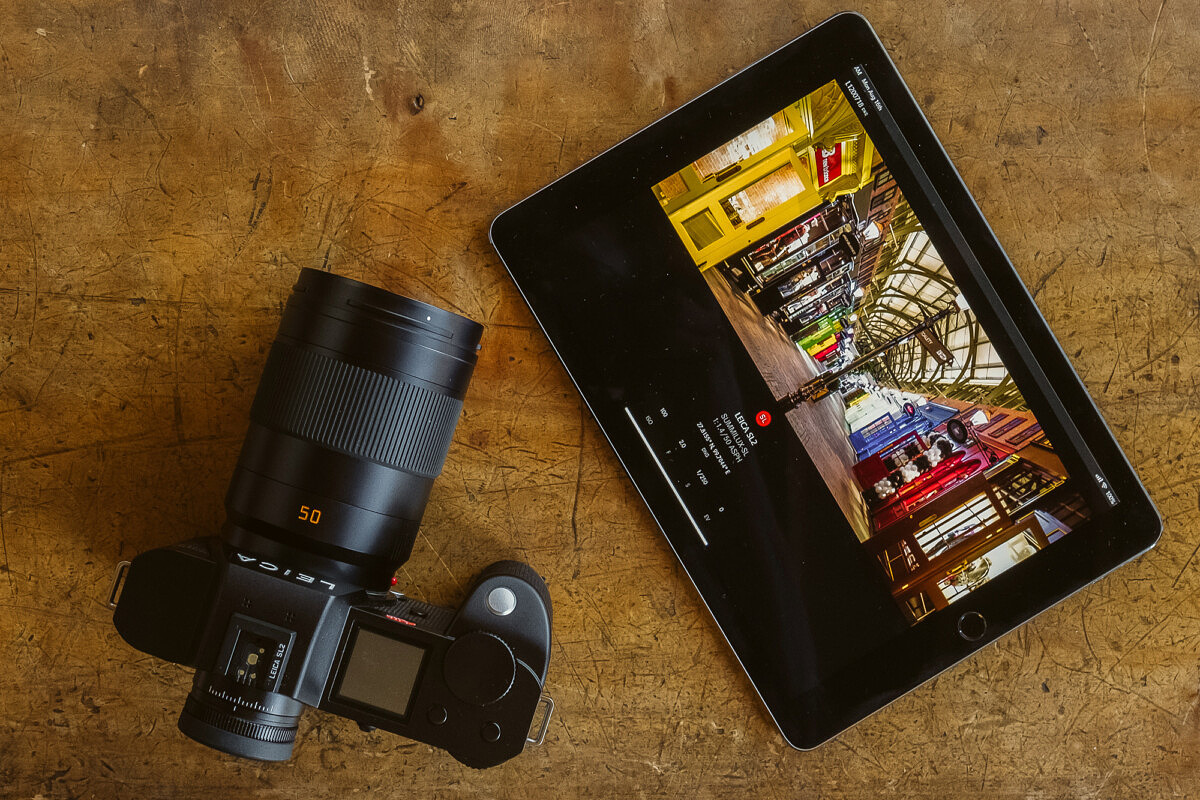
To support the SL2, Leica will be releasing a few software updates. The standard FOTOS app for iOS and Android will be updated to v2.0 through the App Store and Google Play Store, so if you already have the app installed, just keep an eye out for the update. The latest version promised to be about twice as fast loading photos from the camera with more robust and stable connectivity.
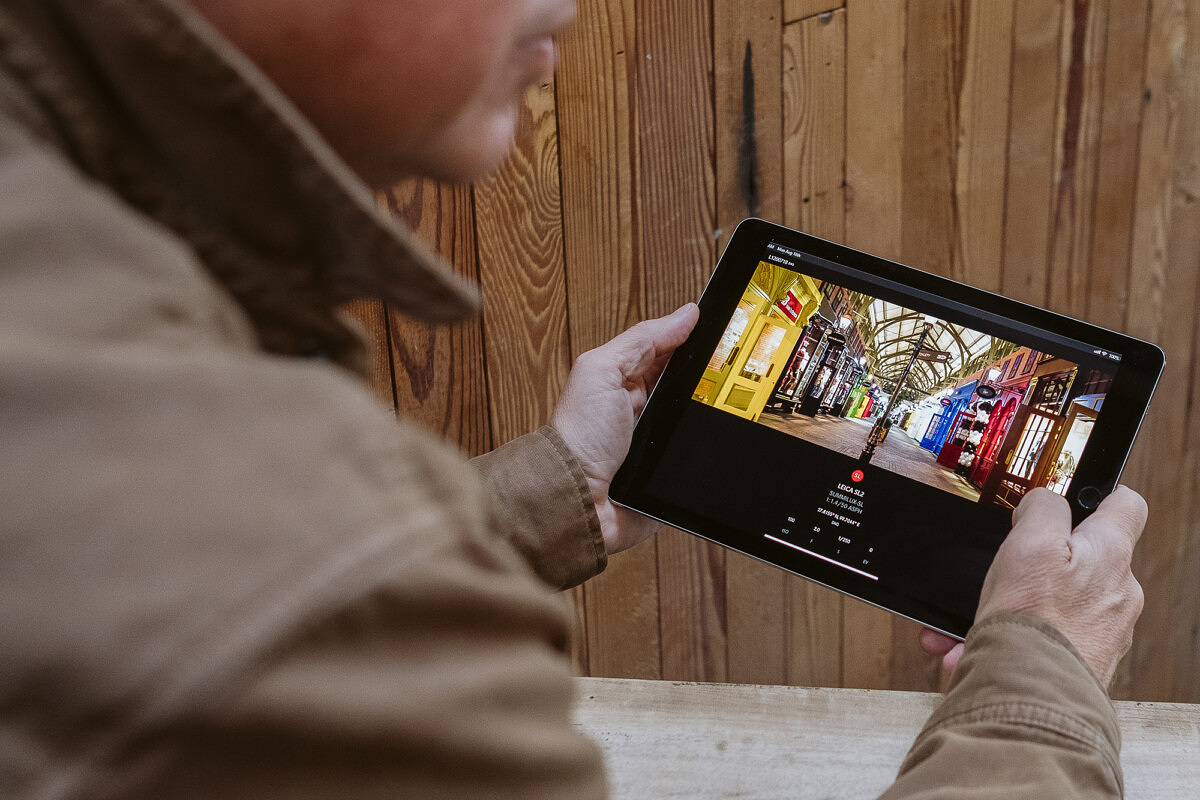
In addition to the free version, Leica will also be rolling out a paid FOTOS Pro version for iOS. For $49.99 per year, the FOTOS Pro app is optimized for iPad, without sacrificing iPhone compatibility. and offers more powerful functionality like the first ever direct integration with Adobe Lightroom Mobile along with video support.

Just press the Lightroom button at the bottom of the Detail View or in Multi-Selection and the photo or selected photos will instantly open in the Lightroom editor. No other imaging app is this seamless when working with Adobe.
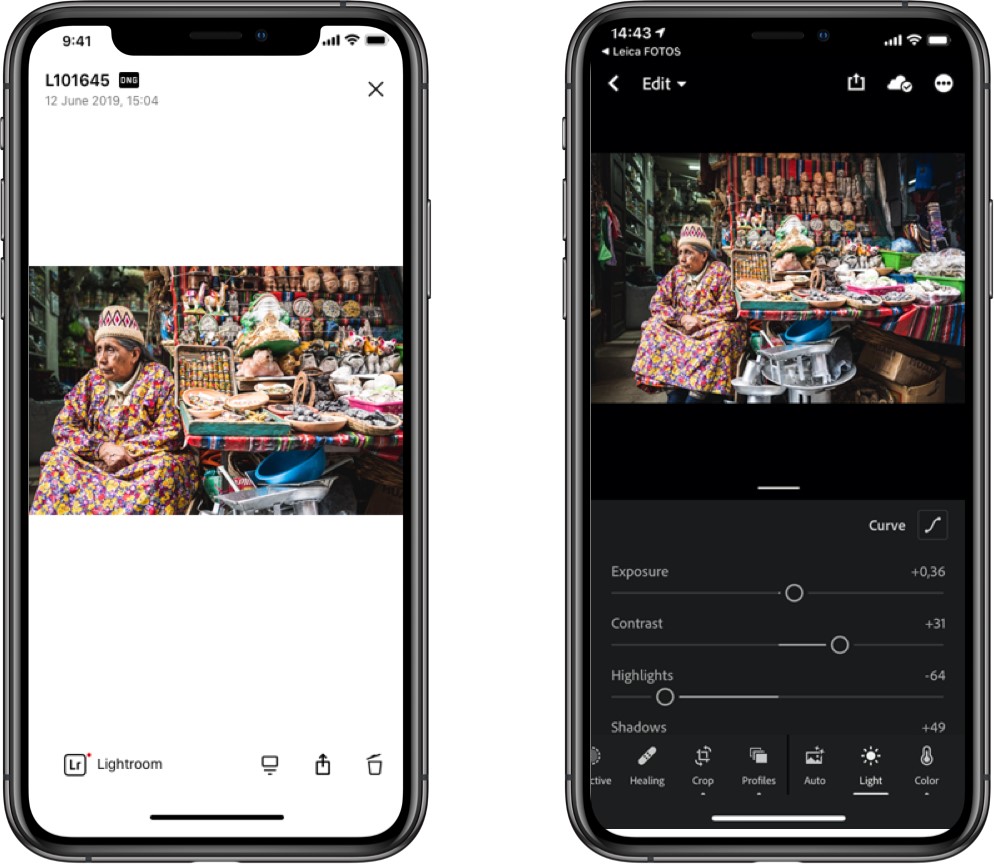
For video producers, you can now use an iPad as a wireless monitor on set and remote control all video functions. Solo vloggers to larger productions will appreciate the added versatility without employing costly transmission systems or cumbersome cable runs.
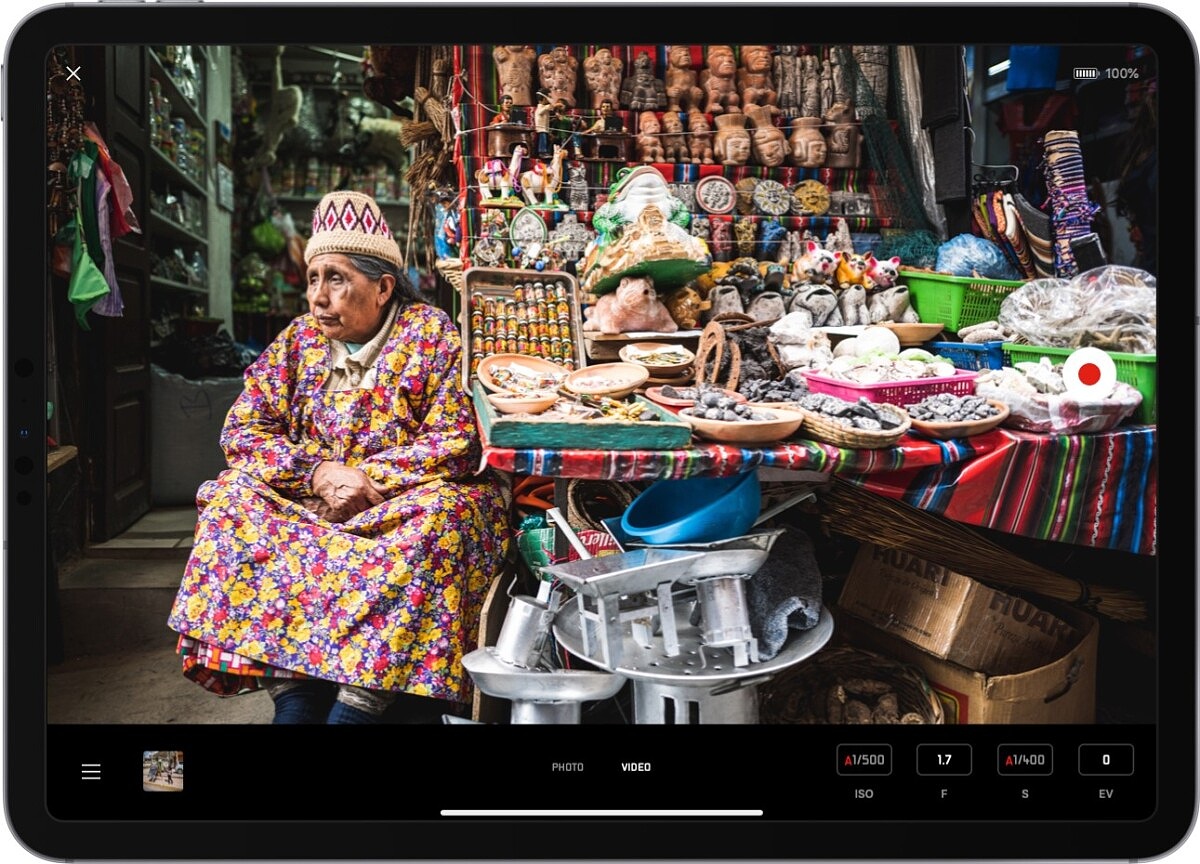
New Handgrip and Remote Release Cable
Be aware that the original SL handgrip and remote release cable will not work with the SL2, nor will Really Right Stuff L-bracket plates. The bottom of the camera is slightly different, as Leica needed to eliminate the anti-rotation hole next to the 1/4-20″ tripod socket to make room for the Image Stabilization sensor. The new cable release can now be used in either the headphone or microphone jack, allowing for greater flexibility if also working with video.
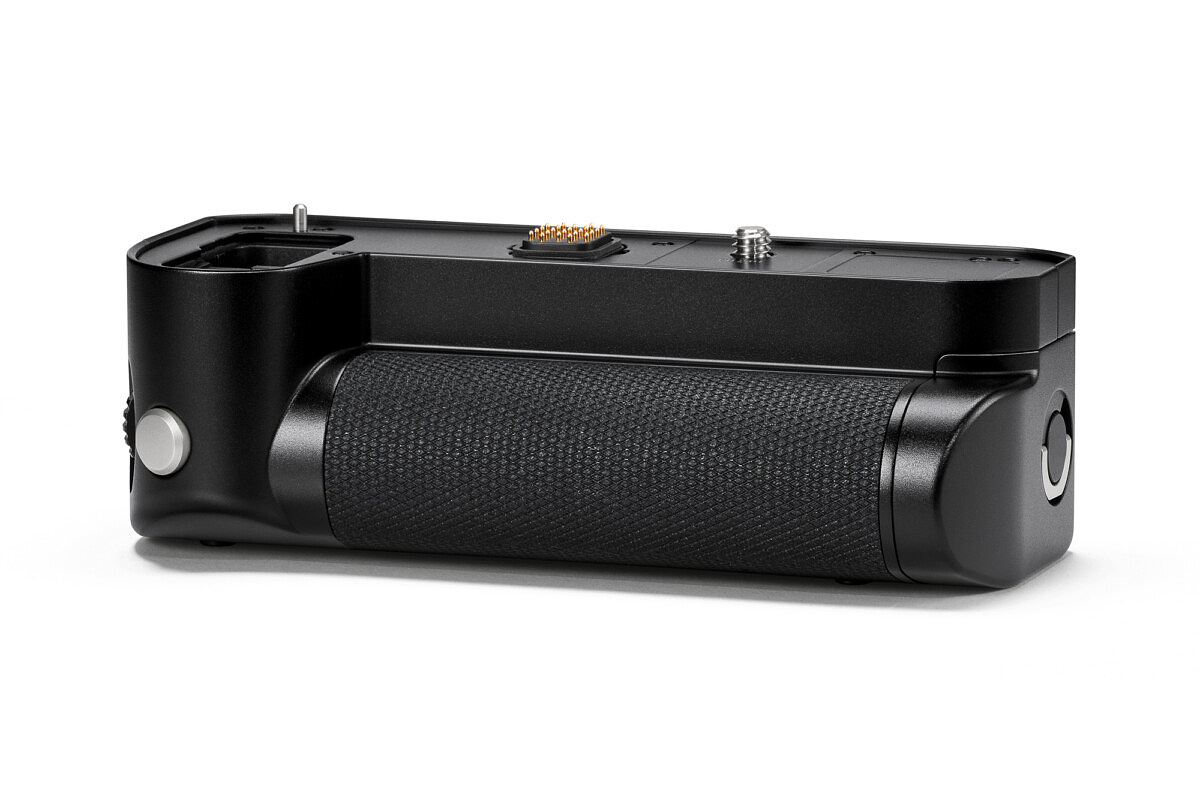
Pricing, Availability and Ordering
The Leica SL2 is expected to start shipping by late November 2019 at a price of $5,995. If you are interested in purchasing the SL2, you can do so at Leica Store Miami by clicking the button below, calling 305-921-4433 or sending an email to info@leicastoremiami.com. If you are interested in trading in any other Leica equipment towards the purchase of the SL2, your best option is to fill out their online trade-in form.
Hands-On Overview Video
Be sure to check out our hands-on overview video for even more information.
SL vs. SL2 Feature Comparison
| Leica SL | Leica SL2 | |
| Resolution | 24 megapixels | 47 megapixels |
| APS-C Resolution | 10 mp | 20 mp |
| In Body Stabilization | No | Yes (5-axis) |
| Dimensions | 147x104x39mm | 146x107x42mm |
| Weight (without battery) | 771 grams | 835 grams |
| Multishot | No | Yes (187 megapixels) |
| Processor | Maestro II | Maestro III |
| Max Shutter Speed | 1/16,000th | 1/40,000th |
| EVF Resolution | 4.4 mp | 5.76 mp |
| EVF Type | LCD | OLED |
| LCD Size | 2.95″ | 3.2″ |
| LCD Resolution | 1.04 mp | 2.10 mp |
| Buffer | 2GB | 4GB |
| Max Frame Rate | 11 fps | 20 fps |
| SD UHS II Slots | 1 (+ one UHS-I) | 2 |
| USB Connection | USB 3.0 | USB 3.1 Type C |
| External Power | No | Yes |
| HDMI | HDMI 1.4a | HDMI 2.0b |
| Video Capability (4K) | Cine4K 30fps | Cine 4K 60fps |
| Video Capability (FHD) | FullHD 120fps | FullHD 180fps |
| Video Sensor Area (4K) | Super35 crop | Full Frame or S35 |
| Video Sensor Area (FHD) | Full Frame or S35 | Full Frame or S35 (150/180 – S35) |
| Internal Video Recording | 4:2:0 8-bit | 4:2:2 10-bit |
| Video Gamma | Rec 709, L-Log | Rec 709, HLG (Rec 2020), L-Log |
| Audio | Adapter Req | 3.5mm in/out |
| WLAN | IEEE802.11g | IEEE802.11ac |
| Bluetooth | No | Yes, BLE 4.2 |
| GPS | Yes | Via FOTOS App |
| Intelligent AF Mode | No | Yes |
| Long Exposure NR | Always On | On or Off |
Press Release
A NEW ICON: LEICA CAMERA ANNOUNCES THE NEW LEICA SL2, SUCCESSOR TO THE TRAILBLAZING LEICA SL
Building on the foundation established in 2015 with the visionary Leica SL-System, Leica Camera proudly introduces the Leica SL2, the storied brand’s new icon and next evolutionary step towards building the perfect all-purpose camera. By listening closely to the valued feedback of photographers and existing SL owners, Leica made many efforts to push the envelope of technological innovation and performance while respecting its heritage of design and legacy. In addition to a technical marvel of pure performance and unmatched build quality, the Leica SL2 is also a joyous experience to use with improved ergonomics and more comfortable grip married to the well-established, simplified three-button control layout, further unifying the Leica design language across multiple product lines. While cutting-edge new features such as in-body image stabilization unlocks newfound potential from legendary Leica M-Lenses, it simultaneously augments the growing selection of SL-Lenses which are some of the finest optics Leica has ever produced. The Leica SL2 is the natural evolution of the innovative Leica SL, serving as a groundbreaking embrace of the future of digital photography and videography while paying homage to its respected history and lineage.
Crafted with conscience
The SL2 is the only mirrorless camera designed and crafted in Germany, with an unmatched all metal solid construction and elegant leather wrap to withstand the time and deliver years of photographic pleasure, thanks to the sustainability guaranteed by consistent firmware updates.
Streamlined design with new status menus
The Leica SL2 offers an innovative user interface whose efficient design allows photographers to focus their attention on the creative process. The design alignment with the existing M and Q systems makes the adjustment even easier for existing Leica photographers.
The main recording parameters can be viewed on the rear display and adjusted quickly and easily with a simple finger tap. A click wheel, a joystick and three strategically placed, individually configurable buttons also contribute to a straightforward operation. Thanks to two dedicated status menus for stills and video recording, the parameters for either shooting mode can be adjusted entirely separately from each other.
Improved ergonomics for stress-free shooting in any situation
Despite significant technical improvements, and the presence of in-body stabilization, the Leica SL2 has kept the same size than its predecessor and feels particularly compact to handle. Improved body design paired with increased durability make the SL2 the perfect companion for all forms of shooting. The SL2’s IP54 certification ensures an elevated weather sealing for more rugged situations, while a new option to turn off noise reduction during long exposures allows for more hands-free shooting. Less worry about the weather and environmental situations means photographers can focus more on getting the shot.
Overall the design of the SL2 recalls more of the iconic Leica identity and traditional design DNA elements that the brand has become known and loved for.
CMOS sensor with 47 megapixels for superior image quality
The unprecedented resolution of the SL2’s CMOS image sensor in full-frame format results in an unparalleled level of detail rendition and image quality. Enormous dynamic range, a color depth of 14 bits per RGB channel and a sensitivity of up to ISO 50,000 enable outstanding image quality in all lighting conditions. Even when combined with Leica TL lenses, which are designed for the smaller sensor format of the Leica TL2 and CL, the SL2’s sensor still delivers an excellent image resolution of over 20 megapixels.
New Leica Object Detection Autofocus
The new Leica Object Detention AF ensures a fast and reliable AF. In addition to an array of modes and features, including face recognition, the SL2’s high-performance AF system also automatically detects whether a subject is stationary or in motion, and subsequently switches between motion and focus priority.
Optical image stabilization through sensor-shift technology
In a major evolution of the SL, the Leica SL2 features a suspended sensor which adjusts its position in order to quickly and efficiently compensate for camera shake. This in-camera method even makes image stabilization available to lenses that are not equipped with their own.
Additionally, in multishot mode, the tripod-mounted camera can record up to eight consecutive frames, whereby the sensor is shifted in half-pixel increments in between every exposure. This key feature results in images with an incredible quadrupled resolution of around 187 megapixels, leading to an extreme increase in detail resolution.
Leica EyeRes® viewfinder with even higher resolution
The camera’s electronic viewfinder now boasts a resolution of 5.76 megapixels, allowing for a large, entirely natural-looking viewfinder image. Simultaneously, the experience is further enhanced when using the touchscreen, which has increased in size to a 3.2-inch diagonal, and now offers a significantly higher resolution of 2.1 megapixels.
Maestro III processor for ultra-fast operation
The new Maestro III processor facilitates a superior operating speed that shines in many aspects of the SL2’s performance. The autofocus is significantly faster and allows for a virtually lag-free shutter release in any shooting situation, which is further complemented by the new Smart AF mode, which autonomously switches between focus priority and shutter release priority. Full-resolution recordings of consecutive images are possible at 10 frames per second with the focal plane shutter, and 20 frames per second with the electronic shutter. Thanks to two UHS-II-compatible SD card slots, raw files can be saved simultaneously in DNG and JPEG format.
Perfect tool for cinematographers
In addition to its great appeal for photographers, the Leica SL2 speaks the language of cinematographers, as the camera is able to record up to 60 frames per second in Cine 4K mode, and up to 180 frames per second in Full-HD mode. Activating Cine mode transforms the SL2 into a manually controlled cine camera as ISO becomes ASA, the shutter speed is marked in degrees on the rotary disk shutter, and the f-stops indicating the aperture ratio are replaced by T-stops, which measure the actual amount of light transmitted through the lens. Connecting audio equipment to the Leica SL2 no longer requires the use of adapters, as the camera now features a build in headphones and mic jack, complemented by a fully-fledged HDMI connector for external monitors.
Limitless connections
Featuring an L bayonet lens mount, the Leica SL2 is not only compatible with the ever-growing portfolio of SL-System lenses, but also with lenses of the TL-System and with the legendary lenses of Leica’s M, S and R-Systems via adapter, providing more than 170 Leica lens options, guaranteed to offer the right fit for any photographic scenario. The L-Mount Alliance expands this scope of possibilities even further, by giving SL2 photographers access to L-mount-compatible lenses from Sigma and Panasonic.
Leica FOTOS App
Of course the new Leica SL2 is supported by Leica FOTOS, the versatile app available for Android and iOS Smartphones. Leica FOTOS connects directly to the camera via Wi-Fi (Bluetooth® is supported where available) and saves the registration details to make future connections between the camera and the app as fast and convenient as possible. Leica FOTOS enables photographers to access the Live View function of the camera and remotely change exposure-relevant settings such as aperture, ISO value, shutter speed and exposure compensation from a smartphone. It naturally also allows wireless control of the shutter release, which opens up entirely new creative opportunities.
Thanks to the high-resolution displays of modern smartphones, pictures can be viewed immediately at full size to assess their sharpness. The exposure parameters are also displayed, which can be extremely helpful for adjusting the settings for subsequent exposures.
As soon as a personal selection has been made, the pictures can either be shared in social networks, or saved for mobile post processing in the smartphone. Leica FOTOS can be used for this in combination with many popular post processing apps. To exploit the full potentials of digital image processing, the pictures can also be transferred to the respective app in DNG RAW data format. If users wish to save the finished pictures after processing on their smartphone, they can take advantage of the option for saving them to a separate Leica Gallery – this keeps painstakingly composed and processed pictures from the Leica FOTOS app separate from simple snapshots. Expect many new features and a whole new mobile workflow experience on the iPad when Leica FOTOS will be available in version 2.0 from November 21, 2019.
The Leica SL2 is available beginning November 21, 2019
Tech Specs
| Camera | Leica SL2 |
| Camera type | Mirrorless full-frame system camera |
| Type no. | 2998 |
| Buffer memory | 4 GB: DNG™: 78 recordings / JPG: > 100 recordings |
| Storage medium | UHS-II (recommended), UHS-I, SD/SDHC/SDXC memory card |
| Material | Full-metal housing made of aluminum and magnesium, leatherette, cover, splash-water protected in compliance with IEC standard 60529 (protection type IP54). |
| Lens mount | Leica L bayonet with contact strip for communication between lens and camera |
| Operating conditions | -10 to +40°C |
| Interfaces | ISO accessory shoe with additional control contacts, HDMI jack 2.0b Type A, USB 3.1 Gen1 Type C, Audio-Out 3.5 mm/Audio-In 3.5 mm, communication interface in the base cover for multifunction hand grip |
| Tripod thread | A 1⁄4 DIN 4503 (1⁄4”) with stainless steel in the base |
| Dimensions (WxHxD) | 146 x 107 x 42 mm |
| Weight | approx. 835 g (without battery) |
| Sensor | |
| Sensor size | CMOS sensor, pixel pitch: 4.3 μm / Fullframe (47.3 MP): 8368 x 5584 pixels / APS-C (20.2 MP): 5504 x 3664 pixels |
| Image Stabilization | 5-axis Body Image Stabilization. Camera stabilizes up to 5.5 stops. |
| Filter | RGB color filter, UV/IR filter, no low-pass filter |
| Processor | Leica Maestro series (Maestro III) |
| File formats | Photo: DNG™ (raw data), DNG + JPG, JPG (DCF, Exif 2.31) Video: MP4: H.264/MPEG-4 AVC (Audio Format: 2ch 48kHz/16 bit, AAC), MOV: H.264/MPEG-4 AVC (Audio Format: 2ch 48 kHz/16 bit, AC-3) |
| Picture resolution | DNG™: 8368 x 5584 pixels (46.7 MP) JPG: 8368 x 5584 pixels (46.7 MP), 6000 x 4000 pixels (24 MP), 4272 x 2848 pixels (12 MP) |
| Color depth | DNG™: 14 bit, JPG: 8 bit |
| Color space | Picture: sRGB, ECI-RGB v2.0, Adobe RGB Video: Rec. 709/Rec. 2020 (HLG)/L-Log |
| File size | DNG™: 84.4 MB JPG: depending on resolution and image content Video: max. length: 29 min, max. file size: 96 GB |
| Recording Mode Video | Video mode: P – A – S – M / Cine mode: M |
| Video resolution/frame rate | MOV 5K: 29.97 fps, 25 fps, 23.98 fps / MOV C4K: 59.94 fps, 50 fps, 29.97 fps, 25 fps, 24 fps / MOV 4K: 59.94 fps, 50 fps, 29.97 fps, 25 fps, 23.98 fps / MOV FHD: 180 fps, 150 fps, 120 fps, 100 fps, 59.94 fps, 50 fps, 29.97 fps, 25 fps, 23.98 fps / MP4 4 K: 59.94 fps, 50 fps, 29.97 fps, 25 fps, 23.98 fps / MP4 FHD: 180 fps, 150 fps, 120 fps, 100 fps, 59.94 fps, 50 fps, 29.97 fps, 25 fps, 23.98 fps |
| Bit Rate | 8/10 bit for recordings on SD card, 10 bit via HDMI output |
| Video Gamma | Rec. 709, L-Log Rec. 2020, HLG Rec. 2020 |
| Viewfinder (EVF) | Resolution: 5,760,000 dots, 120 fps, magnification: 0.78x, aspect ratio: 4:3, frame coverage: 100%, exit pupil position: 21 mm, setting range +2/-4 diopters, with eye sensor for automatic switchover between viewfinder and LCD panel, time delay 0.005 s |
| LCD panel | 3.2“ (backlight LED) with anti-fingerprint and anti-scratch coating, 2,100,000 pixels (dots), format 3:2, touch control available |
| Top display | 1.28“ highly reflective trans-reflective monochrome LCD, 128 x 128 pixels, viewing angle 120°; anti-fingerprint coating |
| Shutter | |
| Shutter type | Electronically controlled focal plane shutter/electronic shutter |
| Shutter speeds | Mech. shutter: 30 min to 1⁄8000 s / Electr. shutter function: 1 s to 1⁄40000 s / Flash Synch: up to 1/250 s |
| Shutter button | Two-stage (1st stage: Activation of the camera electronics including autofocus and exposure metering, 2nd stage: Taking the picture) |
| Self-timer | Delay time: 2 s or 12 s |
| Picture Series | Single Continuous Low Speed (3 fps), Continuous Medium Speed (6 fps), Continuous High Speed (10 fps without AFc/AE/WB), Continuous Very High Speed (20 fps with electr. shutter function without AFc/AE/WB), Interval Shooting, Exposure Bracketing, Multishot |
| Multishot | Generates 2 DNGs: 1x 47 MP, 1x 187 MP (8 pictures are combined into one high-res image) |
| Focusing | |
| Focus Mode | Automatic (Autofocus in modes iAF/AFs/AFc/Touch AF) or manual. With manual setting: Auto Magnification and Focus Peaking optionally available as focus aids |
| Autofocus system | Based on contrast metering and depth mapping |
| Autofocus modes | Intelligent AF (autonomously selects AFs and AFc), AFs (picture taken only after successful focusing), AFc (picture can be taken at any time), AF setting can be saved |
| Autofocus Metering Methods | Spot (can be shifted), Field (can be shifted), Multi-Field, Zone, Face detection, object Tracking, optional Touch AF |
| Autofocus Metering Fields | 225 |
| Exposure | |
| Exposure metering | TTL (‘Through The Lens' exposure metering) |
| Exposure Metering Methods | Spot, Center-Weighted, Multi-Field |
| Exposure modes | Automatic program (P), Aperture priority (A): manual aperture setting, Shutter priority mode (S): manual shutter speed setting Manual (M): manual setting for shutter speed and aperture |
| Exposure Compensation | ±3 EV in 1⁄3 EV increments or 1/2 EV increments |
| Automatic bracketing | 3 or 5 exposures, up to ±3 EV, in 1⁄3 EV increments Shift function: up to ±3 EV, additional LPG-HDR |
| ISO sensitivity range | Auto ISO: ISO 100 to ISO 50000, Manual: ISO 50 to ISO 50000 |
| White balance | Automatic (Auto), Daylight 5200 K, Cloudy 6000 K, Shadow 7000 K, Tungsten 3200 K, HMI 5600 K, Fluorescent Warm 4000 K, Fluorescent Cold 4500 K, Flash 5400 K, Gray Card Live View, Gray Card, Color Temperature 2000 K to 11500 K |
| Flash | |
| Flash unit connector | About the accessory shoe |
| Flash sync time | 1⁄250 sec, slower shutter speeds available, automatic changeover to TTL linear flash mode with HSS-compatible Leica flash units if sync time is undercut |
| Flash exposure metering | Using center-weighted TTL pre-flash metering with Leica flash units (SF 26, 40, 40MkII, 58, 60, 64) or with system-compatible flash units, flash remote control SF C1 |
| Flash exposure compensation | SF 40: ±2 EV in 1⁄2 EV increments, SF 60: ±2 EV in 1⁄3 EV increments |
| Equipment | |
| Microphone | Stereo internal + microphone input 3.5 mm stereo jack |
| Speaker | Mono internal + headphones output 3.5 mm stereo jack |
| WLAN | The Leica FOTOS app is required to use the WLAN function. The Leica app is available from the Apple App Store™ or the Google Play Store™. Compliant with Wi-Fi IEEE802.11b/g/n, 2.4 GHz, channel 1-11 (2412-2462 MHz) and Wi-Fi IEEE802.11ac, 2.4 GHz & 5 GHz, channel 39-48 (5180-5240 MHz), channel 52-64 (5260-5320 MHz), channel 100-140 (5500-5700 MHz) (standard WLAN protocol), encryption method: WLAN-compatible WPA™/WPA2™ |
| Bluetooth | Bluetooth v4.2 (Bluetooth Low Energy (BLE)), 2402 to 2480 MHz |
| GPS | Via Leica FOTOS app |
| Menu languages | English, German, French, Italian, Spanish, Russian, Japanese, Simplified Chinese, Traditional Chinese, Korean |
| Power supply | |
| Rechargeable battery (Leica BP-SCL4) | Lithium-ion rechargeable battery, rated voltage: 7.2 V (DC); capacity: 1860 mAh (min.), approx. 370 recordings (based on CIPA standard, without EVF); charging time: approx. 140 min (after deep discharge); manufacturer: Panasonic Energy (Wuxi) Co. Ltd., Made in China |
| USB Power Supply | USB charger function in standby mode or when switched off, USB power supply when switched on |
| Charger (Leica BC-SCL4) | Input: AC 100–240 V, 50/60 Hz, 0.25 A, automatic switchover; Output: DC 8.4 V 0.85 A; Manufacturer: Salom Electric (Xiamen) Co., Ltd., Made in China |

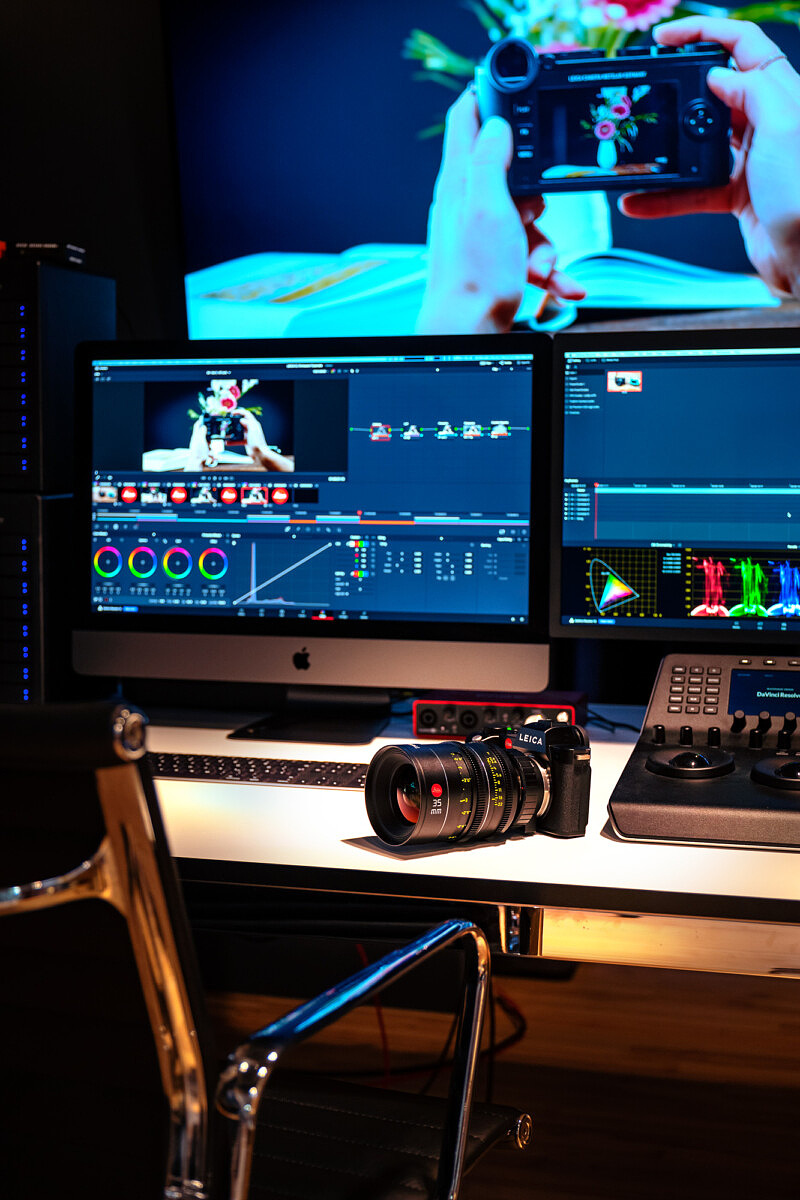
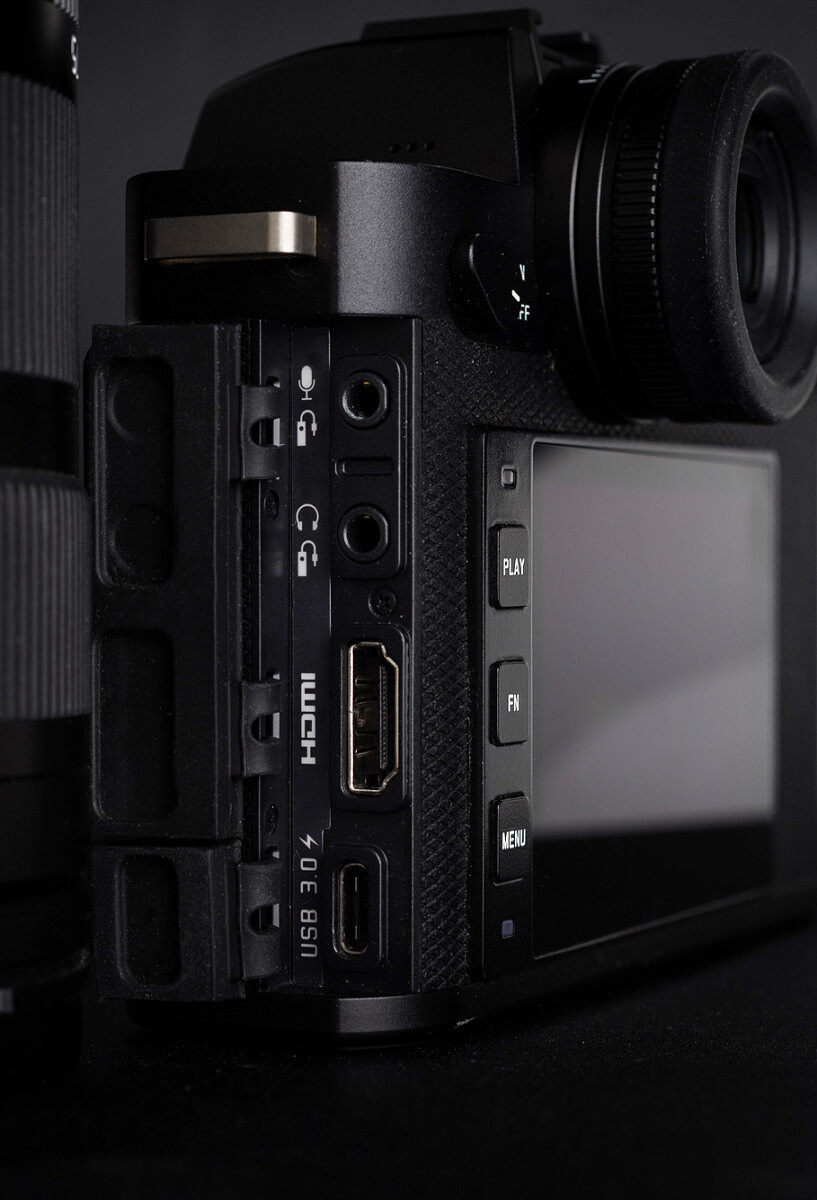
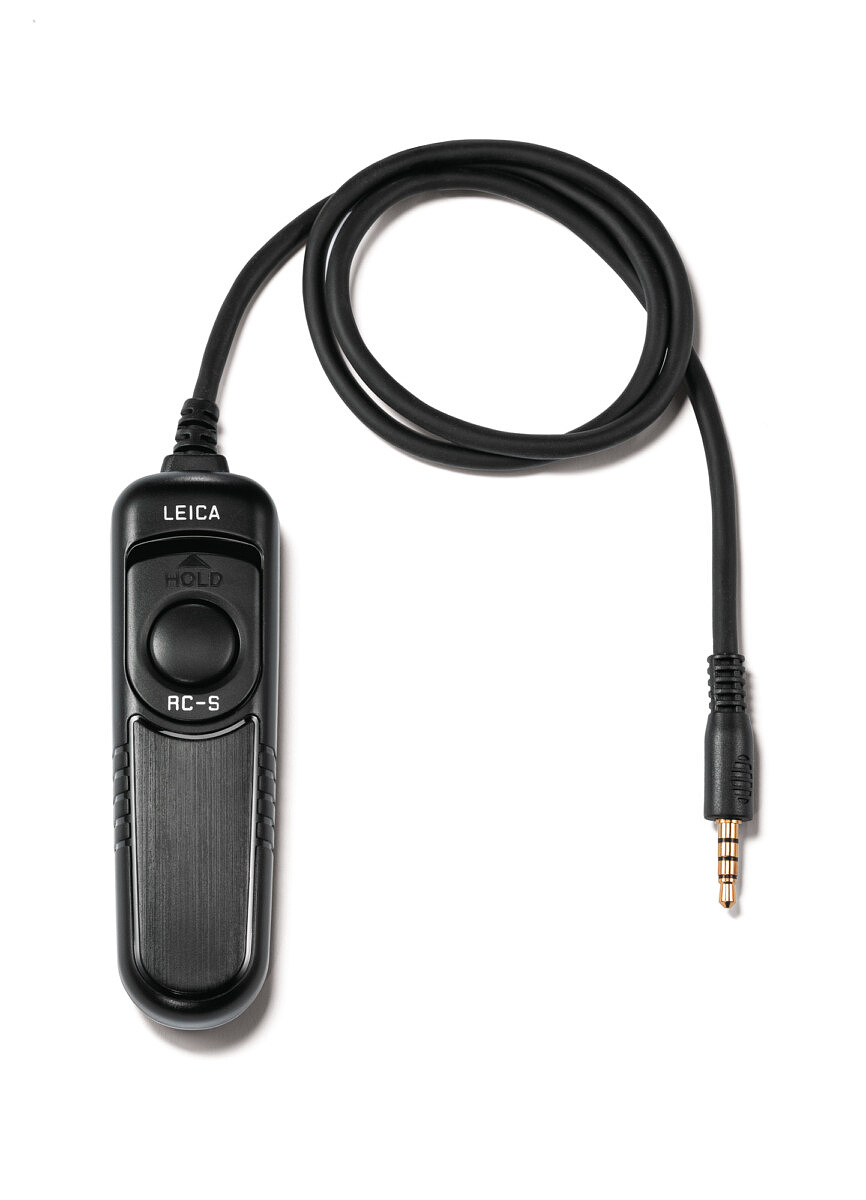
Hopefully we will have a full review soon. I look forward to it :).
How does the GPS via Leica FOTOS app work? Why did they remove the previous built-in GPS?
I don’t know what David’s response will be, but I recently checked GPS accuracy and availability in our city using SL, M10 with VF20, and my cellphone/Lumix software to the S1R. The VF20 was the weakest, requiring minues, a really strong signal and clear sky overhead. The SL built-in GPS did better but not much better, and both were not accurate to better than a few hundred feet laterally, especially if just switched on. My phone (actually any of several of them) gets its position sorted out to better than 10 feet accuracy within a few seconds almost anywhere. The BTLE pairing works effortlessly with the S1R and doesn’t start up the power-hungry WiFi until you actually need it. I think Leica made the right call. Now to see if Fotos gets all of this right.
David, you’ve done run and gun shooting around Miami — when Fotos is final, will you add some comments on how it holds up? Can it stay connected when you take a phone call, for example?
I could not explain better the advantages of using the smartphone as source for GPS Data. Thank you, Scott.
Is there now compatibility with profoto for TTL metering? I will be purchasing this camera from you, for use during events and that would fit perfectly with my profoto lights. If no is there a technical limitation or is just the companies decision?
No Profoto integration has been announced at this point.
Many thanks for sharing all this information, David!
Great review. Thanks for the effort. Looking forward to getting my copy.
Loved the article.very good review.i own the Leica sl for almost 4 years .would I still be able to use the adobe lightroom to process my workflow with the Leica sl2? I have a15inch mac book pro.
Just a note on the laptop question. The 85MB DNG files from the SL2 place a much higher demand on your computer than the SL601 files did. The latest generation MBP with six and eight core processors should be able to handle the files fine, better if equipped with 32GB of RAM vs. the base 16GB. Older generation hardware will work, but you’ll definitely feel it.
I own the Leica sl for almost 4 years.i use Adobe Lightroom 6.3 on my Mac book pro 15inch for my workflow.qusetion is will the above support the Leica SL2 ?
My mistake the Adobe Lightroom I am using is 6.12 not 6.3. Will the 6.12 support the leica sl2 ?
Yes, your version of Lightroom should work ok. But… I’d highly recommend switching over to Lightroom Classic CC. It’s well worth the $10/mo subscription fee to take full advantage of the latest improvements and continual updates.
Will the SL2 finally also accomodate flash support from any of the main manufacturers? Panasonic seems to have Profoto and Elinchrom support but I haven’t heard yet if Leica finally is allowing any protocol outside of manual flash.
Which of the below Leica M lenses will not work with the Leica SL2?
Super-Angulon 1:3.4/21
Summicron 1:2/35
Summicron 1:2/50 Dual Focus
Tele-Elmarit 1:2.8/90
Summicron 1:90
Elmarit 1:2.8/135 (with eyes)
Telyt 1:4/200
Hmm. Looking at the list, I think only the googled 135 might not clear the front of the EVF bump. But otherwise, I’d think you’d be good to go on everything else.
David, thanks for this post and also for your YouTube overview. Do you have any idea if the SL2 has ultrasonic sensor cleaning like the original SL? There’s no mention off it in the SL2 manual .
Hello David.
Regarding the using the USB connector for running the camera from an external battery bank the information in the manual is quite thin.
We know (by trial and error) that with a device having an USB PD port (of the latest generation = 2019) and the corresponding cable the SL2 runs flawlessly.
But for some lenses and some camera modes (burst mode or 4K video) the power is often insufficient.
So could you ask Leica to specify exactly the power requirements and the standards needed for compatibility (e.g. USB PD power distribution) is never mentioned in the manual. So it is actually a very poor description and urgently needs a correction.
I hope you can influence Leica to provide this missing info ASAP.
Thank you for your help and your nice reviews.
Hi David, after months of wanting I have finally but the bullet and I received my SL2 on Friday. As with the Q2 I find the menus and set up very friendly and easy to navigate. The only thing I haven’t been able to find is the color settings. The second thing I set, after turning the sound features off, is the color space. Can you tell me where I can ensure the camera is set to Adobe rgb rather than srgb?
Thanks!
Jeff
The color space only applies to JPG files, not to DNG. So, if you don’t shoot JPG, there’s no need to worry about it.